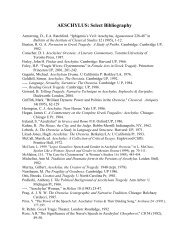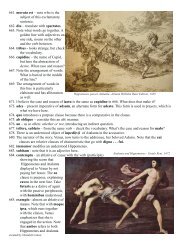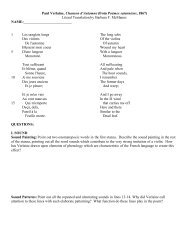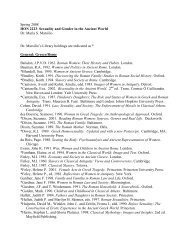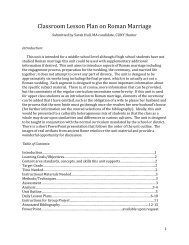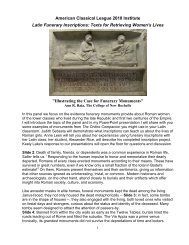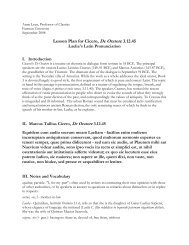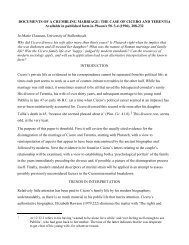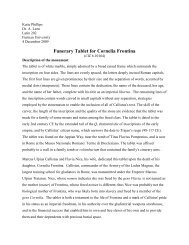Download PDF File - College of New Rochelle
Download PDF File - College of New Rochelle
Download PDF File - College of New Rochelle
You also want an ePaper? Increase the reach of your titles
YUMPU automatically turns print PDFs into web optimized ePapers that Google loves.
The Transformation <strong>of</strong> Libraries Today<br />
○ ○ ○ ○ ○ ○ ○ ○ ○ ○ ○ ○ ○ ○ ○ ○ ○ ○ ○ ○ ○ ○ ○ ○ ○ ○ ○ ○ ○ ○ ○ ○ ○ ○ ○ ○ ○ ○ ○ ○ ○ ○ ○ ○ ○ ○ ○ ○ ○ ○ ○ ○ ○ ○ ○ ○ ○ ○ ○ ○ ○ ○ ○ ○<br />
Keeping<br />
in Step<br />
with the<br />
Times<br />
A Conversation with<br />
Dr. James T. Schleifer,<br />
Dean <strong>of</strong> Gill Library<br />
QUARTERLY REPRINT<br />
With the opening <strong>of</strong> the new<br />
Gill Library, Quarterly Editor<br />
Lenore Boytim Carpinelli<br />
SAS’89 and writer John Coyne recently<br />
sat down with Dr. James Schleifer,<br />
Dean <strong>of</strong> the Library, to discuss the<br />
transformation libraries in general<br />
and Gill Library in particular have<br />
undergone to meet the needs <strong>of</strong> today’s<br />
students and what lies ahead.<br />
Q. In this electronic age, how has the<br />
traditional library changed to remain<br />
relevant?<br />
Dr. Schleifer: It has changed dramatically<br />
since I first became Director <strong>of</strong> Gill Library<br />
in 1987. I see the change particularly with<br />
the librarians. Librarians, on any given<br />
college campus, are among the groups<br />
most computer literate, most comfortable<br />
using computers. Librarians today are a<br />
computer-based pr<strong>of</strong>ession because all <strong>of</strong><br />
the functions <strong>of</strong> the library increasingly are<br />
becoming computerized.<br />
Q. When did this computerization really<br />
begin for libraries?<br />
Dr. Schleifer: It began with the card<br />
catalog in the early ’80s, when libraries<br />
began to make their book records machine<br />
readable. Next came the public, online<br />
catalogs, which was the first big step for<br />
academic libraries. Then automated<br />
circulation, using computers. Increasingly,<br />
beginning in the ’90s, we added new<br />
computerized functions, new databases<br />
and additional computers to provide access<br />
to the Internet.<br />
We’ve also seen libraries change in<br />
their budget allocation. Once upon a<br />
time, the library budget was for books and<br />
journals. Now, a big, competing section <strong>of</strong><br />
the budget is fees for licensed databases.<br />
Q. Do you see a time when the library will<br />
become completely electronic? In other<br />
words, will books just disappear?<br />
Dr. Schleifer: In the early ’90s, there was a<br />
lot <strong>of</strong> discussion that books were going to<br />
disappear, and there was a movement to<br />
put everything online. But the shift<br />
hasn’t happened as quickly as people<br />
thought. It has begun to happen,<br />
however, with journals.<br />
I think the time will come when we<br />
won’t be relying as much on printed<br />
periodicals, but books will take longer.<br />
How long? I don’t know. Probably not for<br />
at least another 20 or 30 years. We may<br />
reach a point where more books are<br />
published online as well as in print. But to<br />
go back and put the millions <strong>of</strong> volumes<br />
already printed online, well, that will take a<br />
long time. ( continued on next page)
The Transformation <strong>of</strong> Libraries Today<br />
○ ○ ○ ○ ○ ○ ○ ○ ○ ○ ○ ○ ○ ○ ○ ○ ○ ○ ○ ○ ○ ○ ○ ○ ○ ○ ○ ○ ○ ○ ○ ○ ○ ○ ○ ○ ○ ○ ○ ○ ○ ○ ○ ○ ○ ○ ○ ○ ○ ○ ○ ○ ○ ○ ○ ○ ○ ○ ○ ○ ○ ○ ○<br />
I also think that reference materials,<br />
such as encyclopedias, are increasingly<br />
going to be online. We’re seeing that<br />
already. There’s also a movement towards<br />
24-hour online reference help where<br />
people can, by e-mail, have reference<br />
questions answered and have access to<br />
reference materials. But the traditional<br />
book, the holdings <strong>of</strong> the library, are not<br />
going to be replaced as quickly by scanned<br />
online material.<br />
Q. Given all that, how prepared is the new<br />
Gill Library to meet the needs <strong>of</strong> students<br />
today and in the immediate future?<br />
Dr. Schleifer: I’m sure there are certain<br />
areas where people could point and say<br />
we’re not state <strong>of</strong> the art, but generally<br />
we’re in very good shape, very strong<br />
shape in terms <strong>of</strong> computerized resources.<br />
We have a very rich collection <strong>of</strong> online<br />
databases.<br />
In the last few years, we’ve also<br />
developed our library home page. We have<br />
a very good home page that has a list <strong>of</strong> all<br />
the periodicals and all <strong>of</strong> our databases.<br />
Our librarians have also organized a lot <strong>of</strong><br />
free Internet resources by subject area so<br />
that students interested in history or health<br />
sciences or women’s studies or whatever<br />
the subject happens to be can easily access<br />
the Internet sites that the librarians and the<br />
faculty recommend. We also have our<br />
library’s catalog online, as well as a place<br />
where students can suggest books to buy,<br />
and a place where students can look at their<br />
own library records and so on and so on.<br />
We now have many more computer<br />
work stations in the library. We have<br />
places that are wired for students to come<br />
with their own laptops, and we provide<br />
laptops at the circulation desk. And, we are<br />
going to be a pilot project for the <strong>College</strong>’s<br />
IT department, who are going to put a<br />
wireless transmitter in the library so that<br />
laptops can be used anywhere.<br />
Q. With all that can be done online, some<br />
might question why we need a physical<br />
library?<br />
Dr. Schleifer: All the technical improvements<br />
do raise the question <strong>of</strong> whether the<br />
traditional, physical library is useful. Has<br />
innovation really outdated a physical<br />
library?<br />
But people are discovering that the<br />
library as a place, as a building, is still very<br />
much in demand. We have seen a big<br />
increase in the number <strong>of</strong> students using<br />
the library. Students are using our<br />
computers; they are using the reference<br />
services; they are here in the study space.<br />
And, they are using the group study<br />
rooms.<br />
The Gill Library is a place where<br />
people can come and get help from the<br />
librarians about how to use these resources,<br />
how to find the right sources, how to use<br />
the databases. It is a place where students<br />
can come to have a quiet study space —<br />
which is important on any college campus<br />
— and just a place where you can go and<br />
sit and read and have the quiet to think<br />
and reflect.<br />
It is also a place where they can see<br />
friends and work with friends. Students<br />
today like to work together, quiz each<br />
other, go over assignments together, and<br />
work on joint projects that might have<br />
been assigned. The new library provides<br />
space for this type <strong>of</strong> group study, as well<br />
as space for the individual student who<br />
just wants to be alone.<br />
I think the answer is — as people<br />
have been discovering — that as<br />
libraries become more sophisticated in the<br />
electronic sense and in computer access<br />
there’s still an enormous student interest<br />
in, and a student demand for, our space.<br />
We’re all feeling, that Gill Library is a<br />
much busier place.<br />
Q. What are some <strong>of</strong> the other special<br />
features <strong>of</strong> the physical library?<br />
Dr. Schleifer: I am most happy about the<br />
climate controlled book vault that we have<br />
for the <strong>College</strong> archive and for the rare<br />
books. We never had that before. Now we<br />
have a place where these precious books<br />
can be kept with the right temperature,<br />
the right humidity. That’s a wonderful<br />
thing.<br />
We also have a very fine library<br />
instruction room, completely networked<br />
and with an interactive system. So each<br />
student who is being instructed on using<br />
databases has their own computer to<br />
actually do what is being asked and the<br />
librarian who’s running the class is able to<br />
see what’s happening on everyone’s screen.<br />
The room can also be used for faculty and<br />
staff workshops. It has many uses.<br />
The Main Reading Room and the<br />
Alumnae/i Room are two very special<br />
places. The big oak reading tables in the<br />
Main Reading Room have been refinished,<br />
and there is new shelving and chairs, new<br />
lighting and a new ceiling. The reading<br />
room is completely transformed, but it<br />
looks the same. It really is a beautiful room.<br />
The other room that’s special is the<br />
Alumnae/i Room. The furniture is new,<br />
the lighting is new, everything is new. But,<br />
again, the look <strong>of</strong> it is the same, and the<br />
sense <strong>of</strong> it is the same. The architects did a<br />
wonderful job. When I think about the<br />
library, I think about those two rooms as<br />
being particularly beautiful, and Gill<br />
Library itself as particularly special.
The Transformation <strong>of</strong> Libraries Today<br />
○ ○ ○ ○ ○ ○ ○ ○ ○ ○ ○ ○ ○ ○ ○ ○ ○ ○ ○ ○ ○ ○ ○ ○ ○ ○ ○ ○ ○ ○ ○ ○ ○ ○ ○ ○ ○ ○ ○ ○ ○ ○ ○ ○ ○ ○ ○ ○ ○ ○ ○ ○ ○ ○ ○ ○ ○ ○ ○ ○ ○ ○ ○ ○<br />
Q. What do you think is the most important<br />
element <strong>of</strong> the new library? Is it technology<br />
or the physical building?<br />
Dr. Schleifer: Well, the technology is here<br />
so the students can find the tools they<br />
need. But what is also here is the attraction<br />
<strong>of</strong> the renovated library itself, the<br />
comfortable space. We’re getting into the<br />
warmer part <strong>of</strong> the year and the air<br />
conditioning will be more apparent to<br />
people. The heating system is new, the<br />
lighting is now much more adequate, and<br />
it’s much more comfortable. There are a<br />
number <strong>of</strong> s<strong>of</strong>t seating areas. The library is<br />
much more attractive and friendlier.<br />
Students are finding their favorite little<br />
areas. They are being drawn into the place.<br />
Q: Besides your <strong>of</strong>fice, have you found a<br />
favorite place in the library that you like?<br />
Dr. Schleifer: Yes. One <strong>of</strong> the great things<br />
about the library right now is that there are<br />
various places where one has a wonderful<br />
perspective. The designer was able to take<br />
the old building and preserve a sense <strong>of</strong> its<br />
large spaces and graciousness. One <strong>of</strong> my<br />
favorite places is the dramatic entryway. It<br />
is a very effective architectural statement.<br />
Another place where you have a<br />
wonderful perspective is the gallery on the<br />
second floor above the front door. I’ve<br />
threatened to make my <strong>of</strong>fice the gallery<br />
area. So, if I wasn’t in my <strong>of</strong>fice, I’d sit in<br />
that gallery. It’s a wonderful space.<br />
Q. To go back to books in your collection<br />
<strong>of</strong> over 200,000 volumes in Gill Library,<br />
what do you think is the most important<br />
collection in terms <strong>of</strong> history or value?<br />
Dr. Schleifer: Well, there is the James<br />
Joyce Collection, the Ursuline Collection,<br />
and the Thomas More Collection. There’s<br />
also a miscellaneous group <strong>of</strong> rare books<br />
that we simply call the Special Collection.<br />
That collection has various Bibles and first<br />
editions, all very special in one way or another.<br />
But when we talk about value, it<br />
really depends on what kind <strong>of</strong> value you<br />
mean. Out <strong>of</strong> all that we have, what would<br />
be impossible to replace? Rare books could<br />
be replaced at great cost, obviously, or in<br />
some cases maybe they couldn’t be<br />
replaced, but there are other examples<br />
elsewhere in the world. But the <strong>College</strong><br />
archive could not be replaced.<br />
In one sense, the Ursuline Collection,<br />
where we have books and documents from<br />
as early as the 17 th century relating to the<br />
Ursuline history, is very valuable. We have<br />
a full collection <strong>of</strong> printed materials about<br />
Ursuline communities, the mission work,<br />
books on the service activities <strong>of</strong> various<br />
Ursuline communities. In fact, it’s the only<br />
such Ursuline collection that is held by an<br />
academic institution.<br />
In terms <strong>of</strong> value as rare books, the<br />
two collections — Joyce and More — are<br />
very valuable. In the More collection, we<br />
have early 16 th century works as well as<br />
17 th , 18 th , 19 th , and 20 th century works.<br />
One volume in the More collection dates<br />
from about 1518. It’s probably the earliest<br />
book we have, nearly 500 years old.<br />
The richness <strong>of</strong> the Joyce Collection<br />
derives from the fact that they are first<br />
editions. In fact, we have first editions <strong>of</strong><br />
most <strong>of</strong> Joyce’s work. We have first<br />
editions <strong>of</strong> Ulysses. The first edition in<br />
England, the first edition in France, the<br />
first pirated American edition, the first<br />
American edition. We have a special<br />
edition illustrated by Matisse and signed<br />
by Matisse. We have another illustrated<br />
edition by Robert Motherwell. And we<br />
have first editions <strong>of</strong> most <strong>of</strong> the rest <strong>of</strong><br />
Joyce’s work, and then a large supporting<br />
body <strong>of</strong> secondary works, Joyce criticism,<br />
that sort <strong>of</strong> thing. We also have a significant<br />
number <strong>of</strong> first and signed early<br />
editions <strong>of</strong> the works <strong>of</strong> Oliver St. John<br />
Gogarty, a contemporary <strong>of</strong> Joyce.<br />
One <strong>of</strong> the first editions <strong>of</strong> Ulysses, one<br />
<strong>of</strong> only 750 <strong>of</strong> that edition, sells in the rare<br />
book shops for $35,000. First editions <strong>of</strong><br />
Joyce are very valuable, as are the early<br />
Thomas More books.<br />
Q. Overall what do you think the impact <strong>of</strong><br />
the new library will be on the college, for<br />
everybody, from the faculty to the staff, to<br />
the students?<br />
Dr. Schleifer: Well, the students have<br />
been responding very, very positively.<br />
They are enjoying the fact they have a<br />
place to study. A place that they can be<br />
proud <strong>of</strong> in terms <strong>of</strong> a modern facility. The<br />
faculty also are very impressed with the<br />
library. They think it’s architecturally very<br />
successful. So, in that respect, the impact<br />
has been very positive.<br />
I believe the new library will help<br />
with recruitment. It’s a great place to show<br />
potential students. I certainly hope it will<br />
help with donors and fund raising because<br />
the last capital campaign was largely<br />
devoted to this project. In addition, I<br />
believe the library propels the <strong>College</strong><br />
forward so people begin to think, “Well,<br />
what’s going to be next?”<br />
A A A



